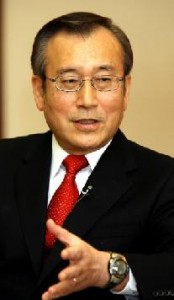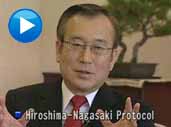Interview with Hiroshima Mayor Tadatoshi Akiba, President of Mayors for Peace
Feb. 27, 2008
In May 2008, Mayors for Peace will present the “Hiroshima-Nagasaki Protocol,” a road map for the elimination of nuclear weapons by the year 2020. This year preparations are being made for the adoption of the Protocol at the U.N. General Assembly in 2009.
At the same time, Hiroshima will host the G8 Summit of Lower House Speakers in September. These political leaders surely share our concern over the fate of humanity and I will encourage them to visit Peace Memorial Museum and speak with A-bomb survivors. By offering such opportunities during their visit, we hope Hiroshima will inspire them to undertake constructive initiatives when they return to their own countries.
Though the Cold War is now over, the state of nuclear weapons in our world is more perilous than ever. Many people believe that the U.S. and Russia are no longer aiming nuclear missiles at one another, but in reality, nothing has really changed. The nuclear powers maintain the same Cold War mentality and policies regarding the use of these weapons. Even worse, awareness of the true horror of nuclear weapons has begun to fade.
In 2003, amidst rising fear that nuclear weapons might actually be used, Mayors for Peace changed the nature of its mission, which, until that point, had focused on educational aims. We set concrete political goals, such as ending the hair-trigger deployment of nuclear missiles and calling on the world’s cities to join forces towards abolishing nuclear weapons by the year 2020. As a result, our membership has tripled to 2028 member cities to date.
There are various reasons for this growth: cities now believe our goals are achievable; people from all walks of life are supporting our work and promoting our message, including individuals, political figures, and NGOs; and the use of computers and the internet has become widespread.
Above all, it’s vital that city governments--the form of government closest to citizens--speak out to protect those citizens and that the number of cities involved in this global movement continues to grow.
At the same time, Hiroshima will host the G8 Summit of Lower House Speakers in September. These political leaders surely share our concern over the fate of humanity and I will encourage them to visit Peace Memorial Museum and speak with A-bomb survivors. By offering such opportunities during their visit, we hope Hiroshima will inspire them to undertake constructive initiatives when they return to their own countries.
Though the Cold War is now over, the state of nuclear weapons in our world is more perilous than ever. Many people believe that the U.S. and Russia are no longer aiming nuclear missiles at one another, but in reality, nothing has really changed. The nuclear powers maintain the same Cold War mentality and policies regarding the use of these weapons. Even worse, awareness of the true horror of nuclear weapons has begun to fade.
In 2003, amidst rising fear that nuclear weapons might actually be used, Mayors for Peace changed the nature of its mission, which, until that point, had focused on educational aims. We set concrete political goals, such as ending the hair-trigger deployment of nuclear missiles and calling on the world’s cities to join forces towards abolishing nuclear weapons by the year 2020. As a result, our membership has tripled to 2028 member cities to date.
There are various reasons for this growth: cities now believe our goals are achievable; people from all walks of life are supporting our work and promoting our message, including individuals, political figures, and NGOs; and the use of computers and the internet has become widespread.
Above all, it’s vital that city governments--the form of government closest to citizens--speak out to protect those citizens and that the number of cities involved in this global movement continues to grow.









